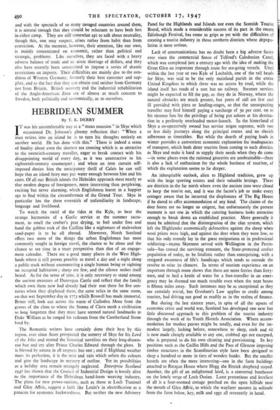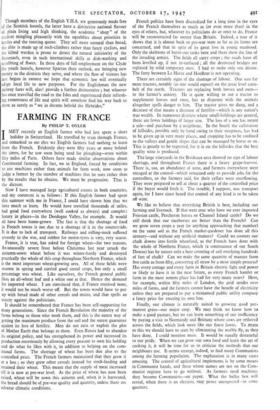HEBRIDEAN SUMMER
By T. K. DERRY To watch the swirl of the tides at the Kyle, to hear the strange harmonies of a Gaelic service at the summer sacra- ment, to smell the crofter's peat drying, to feel under foot and hand the gabbro rock of the Cuillins like a nightmare of malevolent sand-paper is to be all abroad. Moreover, North Scotland offers two more of the things the urban Englishman has most commonly sought in foreign travel, the chance to be alone and the chance to see time in a truer perspective than that of an engage- ment calendar. There are a good many places in the West High- lands where it still proves possible to travel a day and a night along a public track without encountering a single human being or sighting an occupied habitation ; sheep are few, and the silence makes itself heard. As for the sense of time, it is only necessary to stand among the ancient treasures of Dunvegan Castle and reflect that the family which own them now had already had their seat there for five cen- turies when they displayed them, the same relics in the same room, on that wet September day in 1773 whieh Boswell has made immortal. Better still, look out across the waste of Culloden Moor from the graves of the clans to where the Stones of Clava mark a civilisation so long forgotten that they must have seemed natural landmarks to Duke William as he ranged his redcoats from the Cumberland Stone hard by.
The Romantic writers have certainly done their best by this region, ever since Scott prospected the scenery of Skye for his Lord of the Isles and started the historical novelists on their long-drawn- out hue and cry after Prince Charles Edward through the glens. It is blessed by nature in all respects but one ; and if Highland weather mars its perfection, it is the mist and rain which soften the colours and give the landscape its mystery of outline. Yet its possibilities as a holiday area remain strangely neglected. Enterprise Scotland 1947 has shown that the Council of Industrial Design is keenly alive to the importance of the Hebridean hand-loom weaving industry. The plans for new power-stations, such as those at Loch Tunimel and Glen Affric, suggest a faith like Lenin's in electrification as a panacea for economic backwardness. But neither the new Advisory
Panel for the Highlands and Islands nor even the Scottish Tourist Board, which made a considerable success of its part in the recent Edinburgh Festival, has come to grips as yet with the difficulties of creating a tourist industry in those northern districts where depopu- lation is most serious.
Lack of communications has no doubt been a big adverse factor ever since the commercial fiasco of Telford's Caledonian Canal, which was completed just a century ago with the idea of making the Great Glen an important through route for sea-going vessels. Until within the last year or two Kyle of Lochalsh, one of the rail heads for Skye, was said to be the only mainland parish in the entire United Kingdom to which there was no access by road, while the island itself has roads of a sort but no railway. Steamer services might be expected to fill the gap, as they do in Norway, where the natural obstacles are much greater, but ports of call are few and ill provided with piers or landing-stages, so that the unsuspecting traveller may find himself paying a surcharge of 30 per cent. on to his steamer fare for the privilege of being put ashore at his destina- tion in a perilously overloaded motor-launch. In the hinterland of Skye a co-operatively owned bus service reigns supreme, with two or less daily journeys along the principal routes and no slavish adherence to timetables. But while the dearth of paying loads in winter provides a convenient economic explanation for inadequacies of transport, which both deter tourists from coming to such districts as Skye and make it hard to supply their needs when they do come —in some places even the rationed groceries are unobtainable—there is also a lack of enthusiasm for the whole business of tourism, of which the explanation seems to lie deeper.
An inhospitable outlook, alien to Highland tradition, grew up with the large sporting estates and their valuable lettings. There are districts in the far north where even the ancient inns were closed to keep the tourist out, and it was the factor's job to make every cottager aware that he incurred the displeasure of The Big House if he dared to offer accommodation of any kind. The claims of the deer forest are no longer so exigent, but unfortunately the present moment is not one in which the catering business looks attractive enough to break down an established practice. More generally it must be admitted that the disintegration of the clan system, which left the Highlander economically defenceless against the sheep when wool prices were high, and against the deer when they were low, so that his only remedy lay in the peat emigrations or in professional soldiering—ro,000 Skyemen served with Wellington in the Penin- sula—has caused the surviving remnant, the State-protected crofter population of today, to be fatalistic rather than enterprising, with a resigned awareness of life's handicaps which tends to corrode the resolve to seize its chances. In terms of tourism experience on an important through route shows that there are more ferries than ferry- men, and to boil a kettle of water for a foot-traveller in an emer- gency may be deemed too much trouble even when the next house is fifteen miles away. Such instances may be as exceptional as they are certainly trivial, but Gresham's Law applies to credit among tourists, bad driving out good as readily as in the realms of finance.
But during the last sixteen years, in spite of all the upsets of economic crisis and world war, Scotland has developed one new but little discussed approach to this problem of the tourist industry through the work of its Youth Hostels Association. Where accom- modation for modest purses might be totally, and even for the im- modest largely, lacking before, somewhere to sleep, cook and sit is now made cheaply available to any one, crabbed age not excepted, who is prepared to do his own cleaning and provisioning. In key positions such as the Cuillin Hills and the Pass of Glencoe imposing timber structures in the Scandinavian style have been designed to sleep a hundred or more in tiers of wooden bunks. But the smaller hostels are often the more interesting—one in the farm buildings attached to Ratagan House where Hogg the Ettrick shepherd stayed. Another, the gift of an enlightened laird, is a converted boathouse on the lonely verge of Loch Ossian. Least pretentious and loveliest of all is a four-roomed cottage perched on the open hillside near the mouth of Glen Affric, to which the wayfarer mounts in solitude from the farm below, key, milk and eggs all reverently in hand.
Though members of the English Y.H.A. are generously made free of the Scottish hostels, the latter have a distinctive national flavour of plain living and high thinking, the academic " shop " of the student mingling pleasantly with the squabbles about priorities in kettles and the toasting queue. They sell more oatmeal than bread, the elite is made up of rock-climbers rather than fancy cyclists, and the kilted warden is prone to detect the natural inferiority of the Sassenach, even in such international skills as dish-washing and scrubbing of floors. In these days of full employment on the Clyde the youth hostels, however Spartan their outlook, are bringing new money to the districts they serve, and where the flow of visitors has just begun in earnest we hope that economic law will eventually adapt local life to new purposes. For the Englishman the new railway fares will, alas! provide a further disincentive ; but whoever has once travelled the road to the Isles and experienced their refresh- ing remoteness of life and spirit will somehow find his way back to them as surely as "we in dreams behold the Hebrides."



































 Previous page
Previous page